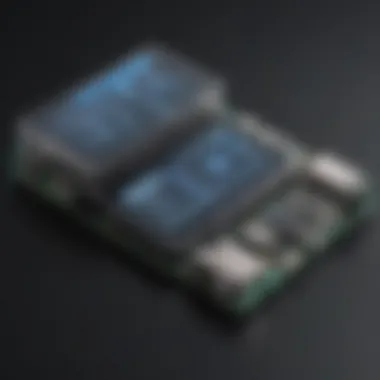DME and HME Software Solutions: A Comprehensive Guide


Intro
Durable Medical Equipment (DME) and Home Medical Equipment (HME) software solutions play an essential role in today’s healthcare landscape. Businesses and providers deploy these solutions to enhance operational efficiency, streamline processes, and ultimately improve patient care. Understanding these software solutions involves looking into their core functionalities and benefits, as well as how they compare with traditional methods and alternatives available in the market. This guide aims to unravel the complexities associated with DME and HME software solutions, providing readers with key insights to make informed decisions.
Software Overview
Definition and Purpose of the Software
DME and HME software are designed specifically to facilitate the management, distribution, and utilization of medical equipment used in home and clinical settings. These solutions serve as a centralized platform that not only tracks inventory but also manages billing and claims processing, providing a seamless experience for providers and patients alike. The purpose of this software is to reduce manual errors, improve efficiency, and ensure regulatory compliance within the healthcare ecosystem.
Key Features and Functionalities
These software solutions come with a variety of features that cater to the unique needs of healthcare providers. Some of the most important functionalities include:
- Inventory Management: Keeps track of equipment stock levels, helping prevent shortages or excess inventory.
- Billing and Claims Processing: Facilitates accurate billing and streamlines claims submission to insurance companies.
- Patient Management: Maintains records of patient usage, prescriptions, and equipment adjustments, which minimizes risks associated with incorrect usage.
- Reporting Tools: Generates analytics and reports, aiding in decision-making processes for operational efficiency.
- Integration Capabilities: Often integrates with Electronic Health Record (EHR) systems, ensuring cohesive data flow and enhanced care deliver.
"Investing in the right DME and HME software can lead to significant cost savings and improved service delivery for patients."
Managing the intricacies of medical equipment is not easy. However, a well-implemented software solution can alleviate some of the pressure and enhance overall operational capabilities.
Comparison with Alternatives
Overview of Competitors in the Market
Various companies provide DME and HME software. Some notable players include:
- **Brightree
- Allscripts
- MEDITECH
- Qventus
- EHR Your Way**
These platforms offer different functionalities targeting various aspects of workflow within healthcare settings. Companies must assess their unique needs before choosing a software solution.
Key Differentiators
Selecting the right DME or HME software involves understanding key differentiators. Assess factors such as:
- User Experience: Ease of interface and training requirements for staff.
- Customization Options: Ability to tailor software features to specific business requirements.
- Scalability: Options for growing businesses to expand capabilities without changing providers.
- Customer support: Availability of assistance during implementation and beyond.
Understanding DME and HME
In the evolving healthcare landscape, understanding Durable Medical Equipment (DME) and Home Medical Equipment (HME) is essential for providers. These categories of medical devices play a crucial role in patient care and efficient operational management. For healthcare organizations, clarity in these definitions ensures proper resource allocation and enhances the quality of care delivered to patients.
Definition of DME
Durable Medical Equipment refers to medical devices that withstand repeated use and are essential for medical care. Examples include wheelchairs, oxygen equipment, and hospital beds. DME must be prescribed by a healthcare professional to ensure it meets the patient's medical needs. The longevity of these devices, combined with their ability to assist patients with daily activities, underscores their importance in care settings.
Definition of HME
Home Medical Equipment encompasses a broader range of devices, specifically designed for use in a home setting. This category includes products that provide assistance in daily living, such as mobility aids, respiratory devices, and monitoring equipment. HME is crucial for patients who require ongoing care outside traditional healthcare facilities. The focus on home use emphasizes convenience and accessibility for patients and caregivers.
The Importance of DME and HME in Healthcare
DME and HME significantly impact patient outcomes, offering support that enhances quality of life. They enable patients to maintain independence, which is vital for mental and emotional well-being. Furthermore, implementing effective DME and HME solutions can lead to operational efficiencies in healthcare systems.


Healthcare providers must prioritize the integration of these devices into their practice. This integration includes training staff to properly manage and oversee the equipment, ensuring regulatory compliance, and optimizing patient care. In summary, DME and HME are indispensable in modern healthcare, warranting thorough understanding and strategic implementation to improve patient care and operational effectiveness.
The Role of Software in DME and HME Management
The integration of software solutions in managing Durable Medical Equipment (DME) and Home Medical Equipment (HME) has fundamentally transformed how healthcare providers handle operations. Software serves as a central component for enhancing efficiency, improving patient outcomes, and ensuring compliance with regulatory standards. Without effective software, managing the complexities of equipment distribution and patient care could become burdensome and error-prone.
Streamlining Operations
Software is essential for streamlining operations within DME and HME management. By automating processes, such as inventory tracking and order fulfillment, organizations can reduce human error and enhance productivity. Key features of these software solutions often include real-time inventory management systems that help providers keep track of equipment availability. This is critical for ensuring that necessary medical devices are on hand when patients need them.
An organized approach is vital, especially as the demand for DME and HME rises. With software tools, companies can effectively manage their supply chain. They can easily analyze order patterns, predict future needs, and adjust inventory levels accordingly. This leads to cost savings as organizations minimize overstock and stockouts.
Enhancing Patient Care
The role of software also extends to improving patient care. By using patient management systems integrated within DME and HME software, providers can maintain detailed patient records and monitor equipment usage. This enables healthcare professionals to tailor their services to individual needs and ensure patients receive appropriate support.
For instance, software can alert providers when equipment is due for maintenance or replacement. Timely alerts help avoid complications arising from faulty equipment, which is crucial for patient safety. Furthermore, software often includes documentation features that streamline communication between healthcare providers and patients, facilitating improved collaboration.
Regulatory Compliance
Regulatory compliance is another significant aspect affecting DME and HME management. Software solutions are designed to keep organizations updated on the latest regulations and ensure adherence. Compliance features may include automated reporting tools that help organizations meet industry standards and government guidelines efficiently.
Tools that monitor regulatory changes can notify users when updates occur, prompting timely adjustments in processes. This proactive approach helps organizations maintain standards while avoiding costly penalties that can arise from non-compliance. Effectively using software not only supports operational efficiency but also fosters a culture of accountability and responsibility within the organization.
"Effective software solutions are not just tools; they are essential partners in providing quality care and managing resources efficiently."
Overall, the role of software in DME and HME management is multifaceted. From streamlining operations to enhancing patient care and ensuring regulatory compliance, these software solutions are vital in today’s healthcare environment.
Key Features of DME and HME Software
DME and HME software solutions play a vital role in the efficient management of medical equipment. Their features significantly influence operational workflows in healthcare settings. Focusing on certain functionalities can lead to improved organization, compliance, and patient care.
Inventory Management
Effective inventory management is crucial for any healthcare provider dealing with DME and HME. This system helps keep track of available equipment and supplies. It reduces the chances of overstocking or stockouts. Utilizing barcoding or RFID technology enables real-time tracking of items. This not only assists in inventory accuracy but also aids in controlling costs.
The automated alerts for low stock levels ensure timely replenishment, preventing disruptions in service. In addition, accurate inventory records can enhance reporting capabilities, enabling trends analysis over time. Providers can make better decisions concerning inventory procurement.
Order Processing and Fulfillment
Order processing is the backbone of any DME and HME operation. Software solutions streamline this process, making it easier to input, manage, and fulfill orders from various channels. By automating order entry, organizations can significantly reduce the chance of human error and improve efficiency.
Integration with e-commerce platforms enhances order fulfillment capabilities. It allows seamless coordination between order placement and delivery. Confirmation notifications to both customers and staff enhance communication. Furthermore, tracking features provide visibility into order status, improving transparency for all parties involved.
Billing and Insurance Verification
Billing and claims submission can be complex in the realm of DME and HME. This software automates these processes, ensuring they are completed correctly and efficiently. Automated billing reduces the administrative burden on staff while minimizing errors that could lead to denied claims.
The inclusion of insurance verification tools ensures that coverage is confirmed prior to service delivery. This step prevents misunderstandings with patients regarding their financial responsibilities. Real-time updates and direct claims submission to insurers help speed up the reimbursement cycle, which can greatly improve cash flow for organizations.


Reporting and Analytics
Data insights are critical for effective decision-making. Software that offers robust reporting and analytics features enables organizations to assess performance metrics. This analysis can identify trends related to equipment usage, financial performance, and patient outcomes.
Customizable reports can be generated to address specific organizational needs. This empowers stakeholders to evaluate operational efficiencies and identify areas for improvement. Furthermore, historical data is invaluable for strategic planning and forecasting, ensuring that businesses remain adaptable in a changing marketplace.
Integration with Other Systems
Finally, the ability to integrate with other healthcare systems is paramount. DME and HME software must work well with electronic health records, billing systems, and customer relationship management tools. This interoperability allows for the seamless flow of information across various departments.
Such integration minimizes data duplication and enhances accuracy across platforms. It fosters a more cohesive healthcare delivery environment, where everyone involved has access to the same information. Effective integration can lead to improved patient care and operational efficiency.
In summary, selecting DME and HME software solutions with these key features is essential for enhancing operational effectiveness and patient satisfaction.
Popular DME and HME Software Solutions
In the realm of Durable Medical Equipment (DME) and Home Medical Equipment (HME), selecting the right software solution is essential. These systems facilitate the management of equipment and aid healthcare providers in delivering quality patient care. The significance of popular DME and HME software solutions showes in their ability to streamline processes, enhance efficiency, and improve user experience for both providers and patients.
Overview of Leading Providers
Several companies have carved a niche in the DME and HME software landscape. Understanding the leading providers is crucial. Key players include:
- Brightree - Known for its comprehensive features, Brightree offers solutions that improve operational efficiency, manage inventory, and ensure compliance with healthcare regulations.
- Kareo - Primarily focused on medical billing, Kareo also provides solutions tailored for DME and HME, integrating billing and patient care functionalities.
- HME Express - This provider is dedicated to helping small and medium-sized businesses manage workflows effectively through user-friendly interfaces.
- TheraNest - While its primary focus is therapy practitioners, TheraNest offers tools beneficial for HME providers too, facilitating patient management and billing processes.
Choosing among these providers depends on specific organizational needs, budget, and the functionality required.
Comparative Analysis of Software Options
A thorough comparative analysis of software options is pivotal. Each software solution carries unique strengths and weaknesses that can impact user experience and operational capabilities. This analysis should cover:
- Functionality: Look for factors such as inventory management, order processing, and analytics capabilities. Software that integrates seamlessly with existing systems is ideal.
- Usability: The interface should be intuitive. Poor usability may lead to inefficiencies, especially in high-stakes healthcare environments.
- Customer Support: Reliable support is crucial. Issues need resolving quickly to avoid disruptions in service.
- Cost: Understand the pricing structure. Some solutions may have upfront costs, while others might involve ongoing subscriptions.
Consider creating a matrix or list that details how each solution aligns with your organizational needs. This clarifies which software fits well and showcases the value of adopting a popular DME and HME software solution.
Choosing the right software is not just about features; it’s about finding a partner that grows with your business.
The analysis of various software options provides clarity. It allows healthcare providers to make informed decisions that support both operational efficiency and patient care.
Selecting the Right Software
Choosing the appropriate DME and HME software is a critical decision for any organization involved in healthcare. The right software will not only enhance operational efficiency but will also improve patient experiences. It is vital for businesses to evaluate their specific needs to ensure the solution aligns with their objectives. The selection process involves understanding various elements, including organizational requirements, from budgeting to training.
Assessing Organizational Needs
Organizations must start by assessing their unique needs. This involves evaluating what specific functionalities are necessary. For example, a small business might focus on basic inventory management, while a larger establishment might require comprehensive billing and compliance features. Questions of integration with existing systems should also be considered. A clear understanding of required features will facilitate a more targeted software search.
- Identify specific needs: Is the focus on inventory, billing, or patient management?
- Consider future growth: Will the software support scaling up operations?
- Evaluate integration: How well will it communicate with current systems and processes?
Budget Considerations


Budgeting is another important factor in selecting DME and HME software. Organizations should determine how much they are willing to invest in software solutions. Costs can vary widely based on features, support, and scalability. It is essential to balance cost with the expected return on investment. A low-cost solution may not fulfill long-term needs, leading to potentially costly upgrades down the line.
Factors to track include:
- Initial costs: Upfront fees versus ongoing expenses.
- Long-term savings: Efficiency increases can reduce operational costs.
- Training and support costs: These may influence overall budgeting decisions.
Implementation and Training Challenges
The implementation and training phases can often be more complicated than expected. Successful deployment requires time, planning, and likely some adjustment within your organization. Training staff is crucial for maximizing the benefit of the software. Poorly trained employees or inadequate training resources can hinder the overall effectiveness of the solution.
Considerations for smooth implementation include:
- Create a timeline: Map out a realistic implementation schedule.
- Develop training programs: Identify who will provide training and how.
- Gather feedback: Post-implementation evaluations help fine-tune processes.
"The substance of the solution lies not just in the software itself but also in how well teams adapt to its adoption."
Selecting the right DME and HME software is integral to success in this sector. By carefully assessing needs, weighing budget considerations, and planning for implementation challenges, organizations can ensure they choose a solution that will provide lasting value in their operations.
Future Trends in DME and HME Software
In an increasingly digital world, the evolution of software solutions for Durable Medical Equipment (DME) and Home Medical Equipment (HME) is crucial. Understanding future trends in this field can help stakeholders remain competitive. The integration of advanced technologies, evolving regulatory landscapes, and the expanding role of telehealth are some areas of focus. These trends are not just innovations; they are transforming how healthcare providers manage operations and improve patient outcomes.
Staying updated on software advancements is essential for optimizing patient care and operational efficiency.
Technological Advancements
Technological advancements are at the forefront of transforming DME and HME software. Cloud computing facilitates real-time data access and storage, which is particularly important for multi-location providers. This agility aids in inventory management, allowing for streamlined order processing and timely response to patient needs. Furthermore, innovations such as artificial intelligence and machine learning are enhancing analytics capabilities.
With these tools, healthcare organizations can better predict equipment needs and manage resources. IoT devices are also influencing DME and HME sectors by enabling remote monitoring. These devices provide valuable data that can lead to more proactive patient care and reduce the need for physical visits.
Impact of Telehealth
The impact of telehealth on DME and HME software cannot be overstated. The pandemic catalyzed a shift toward remote healthcare services. Patients can now receive care from the comfort of their homes, which has implications for effective management of medical equipment. Software solutions must integrate telehealth capabilities to facilitate virtual consultations and assessments.
This integration allows healthcare providers to ensure that patients have the necessary equipment before their appointments. Consequently, the software needs to adapt to support remote prescriptions, equipment tracking, and scheduling. This evolution not only enhances patient convenience but also encourages adherence to treatment plans, fostering better health outcomes.
Regulatory Changes and Their Implications
Regulatory changes continually shape the landscape of DME and HME software. Stakeholders must observe how policies evolve at both federal and state levels. Compliance with regulations can add complexity to software requirements. Thus, software vendors need to ensure their solutions comply with mandates set forth by organizations such as Medicare and the FDA.
The incorporation of compliance tracking features into software solutions enables stakeholders to easily manage documentation and reporting requirements. Furthermore, regulatory changes often prompt updates in billing procedures. It is important for software solutions to remain adaptable in order to stay in line with shifting regulations. Businesses that proactively address these changes are likely to sustain their operational efficacy and maintain a competitive edge.
Ending
In this article, we have examined the critical role that software solutions for Durable Medical Equipment (DME) and Home Medical Equipment (HME) play in the healthcare landscape. The insights presented emphasize the importance of choosing the right software that aligns with organizational goals, enhances operational efficiency, and ultimately improves patient outcomes.
The importance of concluding the analysis lies in recreating a clear perspective on how DME and HME software solutions contribute significantly to the healthcare ecosystem. By understanding key features of these software solutions and the impact they have on operational processes, stakeholders can recognize the direct benefit to patients.
Recap of Key Points
- Understanding DME and HME: Defining what DME and HME are, alongside their importance in delivering healthcare services, sets the foundation for appreciating the software solutions.
- Role of Software: This includes streamlining operations, enhancing patient care, and ensuring compliance with industry regulations. The software serves as a backbone in managing these functions effectively.
- Key Features: Essential features such as inventory management, order processing, and billing integration are highlighted. These features represent how software directly addresses specific operational needs.
- Popular Solutions: An overview of leading software providers helps in recognizing available options and their advantages in the market.
- Selection Process: Assessing organizational needs and understanding budget implications are vital steps in selecting suitable software. Implementation and training also pose challenges that require careful consideration.
- Future Trends: Addressing technological advancements and the growing impact of telehealth prepares organizations for emerging challenges and opportunities.
Final Recommendations for Stakeholders
To make informed decisions, stakeholders must carefully evaluate the specific software needs of their organizations. Here are some recommendations:
- Conduct a Needs Assessment: Evaluate specific needs by engaging teams across departments. This ensures that the selected solution aligns with operational demands.
- Set a Realistic Budget: Financial planning should include both initial investment and ongoing operational costs to avoid budget overruns.
- Pilot Testing: Consider trial periods for software to assess functionality before full-scale implementation. This mitigates risks associated with adopting new technology.
- Focus on Training: Invest in adequate training for end-users to ensure the software is utilized effectively. Training increases user confidence and minimizes resistance to new processes.
- Stay Updated on Trends: Keeping an eye on evolving trends in technology and regulations will aid in remaining competitive and compliant.















